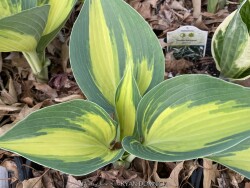

Hosta by far is the most popular and well-known shade plant in the United States. Many thousands of cultivars exist from original species native to China, Japan, and other forested areas in Asia. Hosta foliage arrises from a clump-forming root system and is often large and dramatic with many types of variegation. Flowers, born on tall stocks ranging in shades of white and purple, are equally attractive. Hostas grow best in rich, well-drained soils in full to partial shade. In Eastern Kansas with our average 40 inches of average rainfall, plants are drought tolerant if established in moisture-retentive high-quality soil. Dry-shade areas are best avoided. Afternoon sun with temperatures over 95 degrees F but likely burn the tips of hosta foliage rendering them unattractive for the rest of the year. There is no secondary growth by late summer after flowering and after buds have been set for next year. In northern parts of the country, hostas can handle full sun. In the Southern part of their range further South than zone 7, hosta can really struggle through the long summer heat unless conditions are perfect. Rabbits, deer, slugs, and snails can be a problem generally on small or un-established plants. Large-leaf robust varieties seem to outgrow browsing predators better than small dainty varieties. Methods of control are effective ranging from cages to deer repellents. Generally, a large established planting of hostas will be there for decades gradually getting thicker and denser without a need to divide. Many plantings have been in our display garden for 15-20 years with no weeds ever trying to grow in the shade of the foliage. Hosta foliage is susceptible to late spring freezes so try to cover if possible. During the Easter freeze of April, 2007, thousands of hosta were killed to the ground in eastern Kansas but all returned successfully by May from secondary buds. Hosta's newly unfurling foliage is considered edible when cooked like asparagus or eaten raw in salads. Hosta 'June' is a medium height cultivar. It features small (medium) spearhead-shaped leaves with irregular blue-green edges, chartreuse centers fading to white; lavender flowers. Heavy substance, slug resistant; tolerates partial sun.


Hosta by far is the most popular and well-known shade plant in the United States. Many thousands of cultivars exist from original species native to China, Japan, and other forested areas in Asia. Hosta foliage arrises from a clump-forming root system and is often large and dramatic with many types of variegation. Flowers, born on tall stocks ranging in shades of white and purple, are equally attractive. Hostas grow best in rich, well-drained soils in full to partial shade. In Eastern Kansas with our average 40 inches of average rainfall, plants are drought tolerant if established in moisture-retentive high-quality soil. Dry-shade areas are best avoided. Afternoon sun with temperatures over 95 degrees F but likely burn the tips of hosta foliage rendering them unattractive for the rest of the year. There is no secondary growth by late summer after flowering and after buds have been set for next year. In northern parts of the country, hostas can handle full sun. In the Southern part of their range further South than zone 7, hosta can really struggle through the long summer heat unless conditions are perfect. Rabbits, deer, slugs, and snails can be a problem generally on small or un-established plants. Large-leaf robust varieties seem to outgrow browsing predators better than small dainty varieties. Methods of control are effective ranging from cages to deer repellents. Generally, a large established planting of hostas will be there for decades gradually getting thicker and denser without a need to divide. Many plantings have been in our display garden for 15-20 years with no weeds ever trying to grow in the shade of the foliage. Hosta foliage is susceptible to late spring freezes so try to cover if possible. During the Easter freeze of April, 2007, thousands of hosta were killed to the ground in eastern Kansas but all returned successfully by May from secondary buds. Hosta's newly unfurling foliage is considered edible when cooked like asparagus or eaten raw in salads. Hosta 'Krossa Regal' is a large to giant hosta that grows in an upright, vase-shaped habit. Foliage is thick, waxy, pest resistant, and powdery-blue. Trumpet-shaped, lavender flowers bloom in mid to late summer on tall stalks.
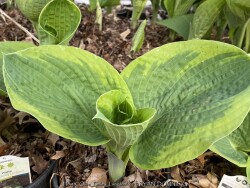

Hosta by far is the most popular and well-known shade plant in the United States. Many thousands of cultivars exist from original species native to China, Japan, and other forested areas in Asia. Hosta foliage arrises from a clump-forming root system and is often large and dramatic with many types of variegation. Flowers, born on tall stocks ranging in shades of white and purple, are equally attractive. Hostas grow best in rich, well-drained soils in full to partial shade. In Eastern Kansas with our average 40 inches of average rainfall, plants are drought tolerant if established in moisture-retentive high-quality soil. Dry-shade areas are best avoided. Afternoon sun with temperatures over 95 degrees F but likely burn the tips of hosta foliage rendering them unattractive for the rest of the year. There is no secondary growth by late summer after flowering and after buds have been set for next year. In northern parts of the country, hostas can handle full sun. In the Southern part of their range further South than zone 7, hosta can really struggle through the long summer heat unless conditions are perfect. Rabbits, deer, slugs, and snails can be a problem generally on small or un-established plants. Large-leaf robust varieties seem to outgrow browsing predators better than small dainty varieties. Methods of control are effective ranging from cages to deer repellents. Generally, a large established planting of hostas will be there for decades gradually getting thicker and denser without a need to divide. Many plantings have been in our display garden for 15-20 years with no weeds ever trying to grow in the shade of the foliage. Hosta foliage is susceptible to late spring freezes so try to cover if possible. During the Easter freeze of April, 2007, thousands of hosta were killed to the ground in eastern Kansas but all returned successfully by May from secondary buds. Hosta's newly unfurling foliage is considered edible when cooked like asparagus or eaten raw in salads. Hosta 'Olive Bailey Langdon' is a large variety. Considered an improved Frances Williams with better color and less prone to burning. Large rounded leaves with powder blue centers and wide irregular gold margins under white blossoms; heavily corrugated with thick substance.
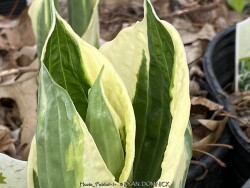

Hosta by far is the most popular and well-known shade plant in the United States. Many thousands of cultivars exist from original species native to China, Japan, and other forested areas in Asia. Hosta foliage arrises from a clump-forming root system and is often large and dramatic with many types of variegation. Flowers, born on tall stocks ranging in shades of white and purple, are equally attractive. Hostas grow best in rich, well-drained soils in full to partial shade. In Eastern Kansas with our average 40 inches of average rainfall, plants are drought tolerant if established in moisture-retentive high-quality soil. Dry-shade areas are best avoided. Afternoon sun with temperatures over 95 degrees F but likely burn the tips of hosta foliage rendering them unattractive for the rest of the year. There is no secondary growth by late summer after flowering and after buds have been set for next year. In northern parts of the country, hostas can handle full sun. In the Southern part of their range further South than zone 7, hosta can really struggle through the long summer heat unless conditions are perfect. Rabbits, deer, slugs, and snails can be a problem generally on small or un-established plants. Large-leaf robust varieties seem to outgrow browsing predators better than small dainty varieties. Methods of control are effective ranging from cages to deer repellents. Generally, a large established planting of hostas will be there for decades gradually getting thicker and denser without a need to divide. Many plantings have been in our display garden for 15-20 years with no weeds ever trying to grow in the shade of the foliage. Hosta foliage is susceptible to late spring freezes so try to cover if possible. During the Easter freeze of April, 2007, thousands of hosta were killed to the ground in eastern Kansas but all returned successfully by May from secondary buds. Hosta's newly unfurling foliage is considered edible when cooked like asparagus or eaten raw in salads.
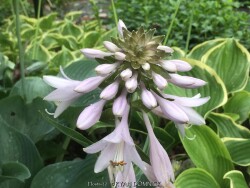

Hosta by far is the most popular and well-known shade plant in the United States. Many thousands of cultivars exist from original species native to China, Japan, and other forested areas in Asia. Hosta foliage arrises from a clump-forming root system and is often large and dramatic with many types of variegation. Flowers, born on tall stocks ranging in shades of white and purple, are equally attractive. Hostas grow best in rich, well-drained soils in full to partial shade. In Eastern Kansas with our average 40 inches of average rainfall, plants are drought tolerant if established in moisture-retentive high-quality soil. Dry-shade areas are best avoided. Afternoon sun with temperatures over 95 degrees F but likely burn the tips of hosta foliage rendering them unattractive for the rest of the year. There is no secondary growth by late summer after flowering and after buds have been set for next year. In northern parts of the country, hostas can handle full sun. In the Southern part of their range further South than zone 7, hosta can really struggle through the long summer heat unless conditions are perfect. Rabbits, deer, slugs, and snails can be a problem generally on small or un-established plants. Large-leaf robust varieties seem to outgrow browsing predators better than small dainty varieties. Methods of control are effective ranging from cages to deer repellents. Generally, a large established planting of hostas will be there for decades gradually getting thicker and denser without a need to divide. Many plantings have been in our display garden for 15-20 years with no weeds ever trying to grow in the shade of the foliage. Hosta foliage is susceptible to late spring freezes so try to cover if possible. During the Easter freeze of April, 2007, thousands of hosta were killed to the ground in eastern Kansas but all returned successfully by May from secondary buds. Hosta's newly unfurling foliage is considered edible when cooked like asparagus or eaten raw in salads. Hosta 'Sagae' is a large, vase-shaped hosta cultivar. It features a medium to tall mound of large of variegated frosty blue-green foliage. Foliage mound will typically spread over time to 36" wide or more.
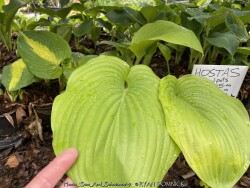

Hosta by far is the most popular and well-known shade plant in the United States. Many thousands of cultivars exist from original species native to China, Japan, and other forested areas in Asia. Hosta foliage arrises from a clump-forming root system and is often large and dramatic with many types of variegation. Flowers, born on tall stocks ranging in shades of white and purple, are equally attractive. Hostas grow best in rich, well-drained soils in full to partial shade. In Eastern Kansas with our average 40 inches of average rainfall, plants are drought tolerant if established in moisture-retentive high-quality soil. Dry-shade areas are best avoided. Afternoon sun with temperatures over 95 degrees F but likely burn the tips of hosta foliage rendering them unattractive for the rest of the year. There is no secondary growth by late summer after flowering and after buds have been set for next year. In northern parts of the country, hostas can handle full sun. In the Southern part of their range further South than zone 7, hosta can really struggle through the long summer heat unless conditions are perfect. Rabbits, deer, slugs, and snails can be a problem generally on small or un-established plants. Large-leaf robust varieties seem to outgrow browsing predators better than small dainty varieties. Methods of control are effective ranging from cages to deer repellents. Generally, a large established planting of hostas will be there for decades gradually getting thicker and denser without a need to divide. Many plantings have been in our display garden for 15-20 years with no weeds ever trying to grow in the shade of the foliage. Hosta foliage is susceptible to late spring freezes so try to cover if possible. During the Easter freeze of April, 2007, thousands of hosta were killed to the ground in eastern Kansas but all returned successfully by May from secondary buds. Hosta's newly unfurling foliage is considered edible when cooked like asparagus or eaten raw in salads. Hosta 'Sum and Substance' is a giant! It features huge chartreuse round leaves with heavy puckering, very thick substance; slug resistant. Vigorous; requires some sun to enhance its golden color. Lavender flowers on tall 50" scapes.


Hosta by far is the most popular and well-known shade plant in the United States. Many thousands of cultivars exist from original species native to China, Japan, and other forested areas in Asia. Hosta foliage arrises from a clump-forming root system and is often large and dramatic with many types of variegation. Flowers, born on tall stocks ranging in shades of white and purple, are equally attractive. Hostas grow best in rich, well-drained soils in full to partial shade. In Eastern Kansas with our average 40 inches of average rainfall, plants are drought tolerant if established in moisture-retentive high-quality soil. Dry-shade areas are best avoided. Afternoon sun with temperatures over 95 degrees F but likely burn the tips of hosta foliage rendering them unattractive for the rest of the year. There is no secondary growth by late summer after flowering and after buds have been set for next year. In northern parts of the country, hostas can handle full sun. In the Southern part of their range further South than zone 7, hosta can really struggle through the long summer heat unless conditions are perfect. Rabbits, deer, slugs, and snails can be a problem generally on small or un-established plants. Large-leaf robust varieties seem to outgrow browsing predators better than small dainty varieties. Methods of control are effective ranging from cages to deer repellents. Generally, a large established planting of hostas will be there for decades gradually getting thicker and denser without a need to divide. Many plantings have been in our display garden for 15-20 years with no weeds ever trying to grow in the shade of the foliage. Hosta foliage is susceptible to late spring freezes so try to cover if possible. During the Easter freeze of April, 2007, thousands of hosta were killed to the ground in eastern Kansas but all returned successfully by May from secondary buds. Hosta's newly unfurling foliage is considered edible when cooked like asparagus or eaten raw in salads. Hosta 'T-Rex' is a giant. It forms absolutely huge clumps of blue-green leaves measuring 18" long and 14"wide! Wonderful puckering and deep veins add interest, a focal point for any garden. Near white flowers.
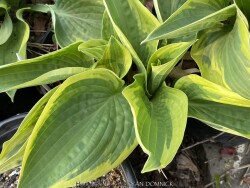

Hosta by far is the most popular and well-known shade plant in the United States. Many thousands of cultivars exist from original species native to China, Japan, and other forested areas in Asia. Hosta foliage arrises from a clump-forming root system and is often large and dramatic with many types of variegation. Flowers, born on tall stocks ranging in shades of white and purple, are equally attractive. Hostas grow best in rich, well-drained soils in full to partial shade. In Eastern Kansas with our average 40 inches of average rainfall, plants are drought tolerant if established in moisture-retentive high-quality soil. Dry-shade areas are best avoided. Afternoon sun with temperatures over 95 degrees F but likely burn the tips of hosta foliage rendering them unattractive for the rest of the year. There is no secondary growth by late summer after flowering and after buds have been set for next year. In northern parts of the country, hostas can handle full sun. In the Southern part of their range further South than zone 7, hosta can really struggle through the long summer heat unless conditions are perfect. Rabbits, deer, slugs, and snails can be a problem generally on small or un-established plants. Large-leaf robust varieties seem to outgrow browsing predators better than small dainty varieties. Methods of control are effective ranging from cages to deer repellents. Generally, a large established planting of hostas will be there for decades gradually getting thicker and denser without a need to divide. Many plantings have been in our display garden for 15-20 years with no weeds ever trying to grow in the shade of the foliage. Hosta foliage is susceptible to late spring freezes so try to cover if possible. During the Easter freeze of April, 2007, thousands of hosta were killed to the ground in eastern Kansas but all returned successfully by May from secondary buds. Hosta's newly unfurling foliage is considered edible when cooked like asparagus or eaten raw in salads. Hosta 'Wide Brim' is a medium variety with heart-shaped green leaves with wide irregular creamy-yellow margins. Good substance with slight puckering under pale lavender flowers.


Hosta by far is the most popular and well-known shade plant in the United States. Many thousands of cultivars exist from original species native to China, Japan, and other forested areas in Asia. Hosta foliage arrises from a clump-forming root system and is often large and dramatic with many types of variegation. Flowers, born on tall stocks ranging in shades of white and purple, are equally attractive. Hostas grow best in rich, well-drained soils in full to partial shade. In Eastern Kansas with our average 40 inches of average rainfall, plants are drought tolerant if established in moisture-retentive high-quality soil. Dry-shade areas are best avoided. Afternoon sun with temperatures over 95 degrees F but likely burn the tips of hosta foliage rendering them unattractive for the rest of the year. There is no secondary growth by late summer after flowering and after buds have been set for next year. In northern parts of the country, hostas can handle full sun. In the Southern part of their range further South than zone 7, hosta can really struggle through the long summer heat unless conditions are perfect. Rabbits, deer, slugs, and snails can be a problem generally on small or un-established plants. Large-leaf robust varieties seem to outgrow browsing predators better than small dainty varieties. Methods of control are effective ranging from cages to deer repellents. Generally, a large established planting of hostas will be there for decades gradually getting thicker and denser without a need to divide. Many plantings have been in our display garden for 15-20 years with no weeds ever trying to grow in the shade of the foliage. Hosta foliage is susceptible to late spring freezes so try to cover if possible. During the Easter freeze of April, 2007, thousands of hosta were killed to the ground in eastern Kansas but all returned successfully by May from secondary buds. Hosta's newly unfurling foliage is considered edible when cooked like asparagus or eaten raw in salads.
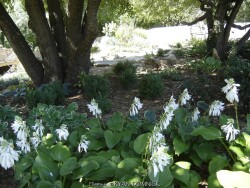

Hosta by far is the most popular and well-known shade plant in the United States. Many thousands of cultivars exist from original species native to China, Japan, and other forested areas in Asia. Hosta foliage arrises from a clump-forming root system and is often large and dramatic with many types of variegation. Flowers, born on tall stocks ranging in shades of white and purple, are equally attractive. Hostas grow best in rich, well-drained soils in full to partial shade. In Eastern Kansas with our average 40 inches of average rainfall, plants are drought tolerant if established in moisture-retentive high-quality soil. Dry-shade areas are best avoided. Afternoon sun with temperatures over 95 degrees F but likely burn the tips of hosta foliage rendering them unattractive for the rest of the year. There is no secondary growth by late summer after flowering and after buds have been set for next year. In northern parts of the country, hostas can handle full sun. In the Southern part of their range further South than zone 7, hosta can really struggle through the long summer heat unless conditions are perfect. Rabbits, deer, slugs, and snails can be a problem generally on small or un-established plants. Large-leaf robust varieties seem to outgrow browsing predators better than small dainty varieties. Methods of control are effective ranging from cages to deer repellents. Generally, a large established planting of hostas will be there for decades gradually getting thicker and denser without a need to divide. Many plantings have been in our display garden for 15-20 years with no weeds ever trying to grow in the shade of the foliage. Hosta foliage is susceptible to late spring freezes so try to cover if possible. During the Easter freeze of April, 2007, thousands of hosta were killed to the ground in eastern Kansas but all returned successfully by May from secondary buds. Hosta's newly unfurling foliage is considered edible when cooked like asparagus or eaten raw in salads.


Hosta by far is the most popular and well-known shade plant in the United States. Many thousands of cultivars exist from original species native to China, Japan, and other forested areas in Asia. Hosta foliage arrises from a clump-forming root system and is often large and dramatic with many types of variegation. Flowers, born on tall stocks ranging in shades of white and purple, are equally attractive. Hostas grow best in rich, well-drained soils in full to partial shade. In Eastern Kansas with our average 40 inches of average rainfall, plants are drought tolerant if established in moisture-retentive high-quality soil. Dry-shade areas are best avoided. Afternoon sun with temperatures over 95 degrees F but likely burn the tips of hosta foliage rendering them unattractive for the rest of the year. There is no secondary growth by late summer after flowering and after buds have been set for next year. In northern parts of the country, hostas can handle full sun. In the Southern part of their range further South than zone 7, hosta can really struggle through the long summer heat unless conditions are perfect. Rabbits, deer, slugs, and snails can be a problem generally on small or un-established plants. Large-leaf robust varieties seem to outgrow browsing predators better than small dainty varieties. Methods of control are effective ranging from cages to deer repellents. Generally, a large established planting of hostas will be there for decades gradually getting thicker and denser without a need to divide. Many plantings have been in our display garden for 15-20 years with no weeds ever trying to grow in the shade of the foliage. Hosta foliage is susceptible to late spring freezes so try to cover if possible. During the Easter freeze of April, 2007, thousands of hosta were killed to the ground in eastern Kansas but all returned successfully by May from secondary buds. Hosta's newly unfurling foliage is considered edible when cooked like asparagus or eaten raw in salads.
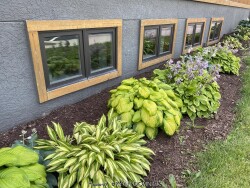

Hosta by far is the most popular and well-known shade plant in the United States. Many thousands of cultivars exist from original species native to China, Japan, and other forested areas in Asia. Hosta foliage arrises from a clump-forming root system and is often large and dramatic with many types of variegation. Flowers, born on tall stocks ranging in shades of white and purple, are equally attractive. Hostas grow best in rich, well-drained soils in full to partial shade. In Eastern Kansas with our average 40 inches of average rainfall, plants are drought tolerant if established in moisture-retentive high-quality soil. Dry-shade areas are best avoided. Afternoon sun with temperatures over 95 degrees F but likely burn the tips of hosta foliage rendering them unattractive for the rest of the year. There is no secondary growth by late summer after flowering and after buds have been set for next year. In northern parts of the country, hostas can handle full sun. In the Southern part of their range further South than zone 7, hosta can really struggle through the long summer heat unless conditions are perfect. Rabbits, deer, slugs, and snails can be a problem generally on small or un-established plants. Large-leaf robust varieties seem to outgrow browsing predators better than small dainty varieties. Methods of control are effective ranging from cages to deer repellents. Generally, a large established planting of hostas will be there for decades gradually getting thicker and denser without a need to divide. Many plantings have been in our display garden for 15-20 years with no weeds ever trying to grow in the shade of the foliage. Hosta foliage is susceptible to late spring freezes so try to cover if possible. During the Easter freeze of April, 2007, thousands of hosta were killed to the ground in eastern Kansas but all returned successfully by May from secondary buds. Hosta's newly unfurling foliage is considered edible when cooked like asparagus or eaten raw in salads.


Hosta by far is the most popular and well-known shade plant in the United States. Many thousands of cultivars exist from original species native to China, Japan, and other forested areas in Asia. Hosta foliage arrises from a clump-forming root system and is often large and dramatic with many types of variegation. Flowers, born on tall stocks ranging in shades of white and purple, are equally attractive. Hostas grow best in rich, well-drained soils in full to partial shade. In Eastern Kansas with our average 40 inches of average rainfall, plants are drought tolerant if established in moisture-retentive high-quality soil. Dry-shade areas are best avoided. Afternoon sun with temperatures over 95 degrees F but likely burn the tips of hosta foliage rendering them unattractive for the rest of the year. There is no secondary growth by late summer after flowering and after buds have been set for next year. In northern parts of the country, hostas can handle full sun. In the Southern part of their range further South than zone 7, hosta can really struggle through the long summer heat unless conditions are perfect. Rabbits, deer, slugs, and snails can be a problem generally on small or un-established plants. Large-leaf robust varieties seem to outgrow browsing predators better than small dainty varieties. Methods of control are effective ranging from cages to deer repellents. Generally, a large established planting of hostas will be there for decades gradually getting thicker and denser without a need to divide. Many plantings have been in our display garden for 15-20 years with no weeds ever trying to grow in the shade of the foliage. Hosta foliage is susceptible to late spring freezes so try to cover if possible. During the Easter freeze of April, 2007, thousands of hosta were killed to the ground in eastern Kansas but all returned successfully by May from secondary buds. Hosta's newly unfurling foliage is considered edible when cooked like asparagus or eaten raw in salads.
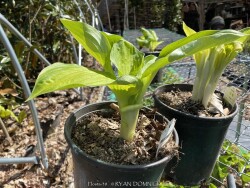

Hosta by far is the most popular and well-known shade plant in the United States. Many thousands of cultivars exist from original species native to China, Japan, and other forested areas in Asia. Hosta foliage arrises from a clump-forming root system and is often large and dramatic with many types of variegation. Flowers, born on tall stocks ranging in shades of white and purple, are equally attractive. Hostas grow best in rich, well-drained soils in full to partial shade. In Eastern Kansas with our average 40 inches of average rainfall, plants are drought tolerant if established in moisture-retentive high-quality soil. Dry-shade areas are best avoided. Afternoon sun with temperatures over 95 degrees F but likely burn the tips of hosta foliage rendering them unattractive for the rest of the year. There is no secondary growth by late summer after flowering and after buds have been set for next year. In northern parts of the country, hostas can handle full sun. In the Southern part of their range further South than zone 7, hosta can really struggle through the long summer heat unless conditions are perfect. Rabbits, deer, slugs, and snails can be a problem generally on small or un-established plants. Large-leaf robust varieties seem to outgrow browsing predators better than small dainty varieties. Methods of control are effective ranging from cages to deer repellents. Generally, a large established planting of hostas will be there for decades gradually getting thicker and denser without a need to divide. Many plantings have been in our display garden for 15-20 years with no weeds ever trying to grow in the shade of the foliage. Hosta foliage is susceptible to late spring freezes so try to cover if possible. During the Easter freeze of April, 2007, thousands of hosta were killed to the ground in eastern Kansas but all returned successfully by May from secondary buds. Hosta's newly unfurling foliage is considered edible when cooked like asparagus or eaten raw in salads.
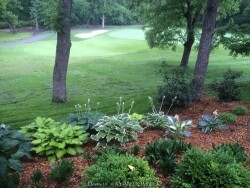

Hosta by far is the most popular and well-known shade plant in the United States. Many thousands of cultivars exist from original species native to China, Japan, and other forested areas in Asia. Hosta foliage arrises from a clump-forming root system and is often large and dramatic with many types of variegation. Flowers, born on tall stocks ranging in shades of white and purple, are equally attractive. Hostas grow best in rich, well-drained soils in full to partial shade. In Eastern Kansas with our average 40 inches of average rainfall, plants are drought tolerant if established in moisture-retentive high-quality soil. Dry-shade areas are best avoided. Afternoon sun with temperatures over 95 degrees F but likely burn the tips of hosta foliage rendering them unattractive for the rest of the year. There is no secondary growth by late summer after flowering and after buds have been set for next year. In northern parts of the country, hostas can handle full sun. In the Southern part of their range further South than zone 7, hosta can really struggle through the long summer heat unless conditions are perfect. Rabbits, deer, slugs, and snails can be a problem generally on small or un-established plants. Large-leaf robust varieties seem to outgrow browsing predators better than small dainty varieties. Methods of control are effective ranging from cages to deer repellents. Generally, a large established planting of hostas will be there for decades gradually getting thicker and denser without a need to divide. Many plantings have been in our display garden for 15-20 years with no weeds ever trying to grow in the shade of the foliage. Hosta foliage is susceptible to late spring freezes so try to cover if possible. During the Easter freeze of April, 2007, thousands of hosta were killed to the ground in eastern Kansas but all returned successfully by May from secondary buds. Hosta's newly unfurling foliage is considered edible when cooked like asparagus or eaten raw in salads.
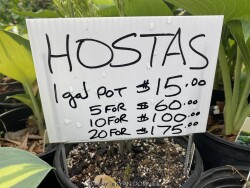

Hosta by far is the most popular and well-known shade plant in the United States. Many thousands of cultivars exist from original species native to China, Japan, and other forested areas in Asia. Hosta foliage arrises from a clump-forming root system and is often large and dramatic with many types of variegation. Flowers, born on tall stocks ranging in shades of white and purple, are equally attractive. Hostas grow best in rich, well-drained soils in full to partial shade. In Eastern Kansas with our average 40 inches of average rainfall, plants are drought tolerant if established in moisture-retentive high-quality soil. Dry-shade areas are best avoided. Afternoon sun with temperatures over 95 degrees F but likely burn the tips of hosta foliage rendering them unattractive for the rest of the year. There is no secondary growth by late summer after flowering and after buds have been set for next year. In northern parts of the country, hostas can handle full sun. In the Southern part of their range further South than zone 7, hosta can really struggle through the long summer heat unless conditions are perfect. Rabbits, deer, slugs, and snails can be a problem generally on small or un-established plants. Large-leaf robust varieties seem to outgrow browsing predators better than small dainty varieties. Methods of control are effective ranging from cages to deer repellents. Generally, a large established planting of hostas will be there for decades gradually getting thicker and denser without a need to divide. Many plantings have been in our display garden for 15-20 years with no weeds ever trying to grow in the shade of the foliage. Hosta foliage is susceptible to late spring freezes so try to cover if possible. During the Easter freeze of April, 2007, thousands of hosta were killed to the ground in eastern Kansas but all returned successfully by May from secondary buds. Hosta's newly unfurling foliage is considered edible when cooked like asparagus or eaten raw in salads.
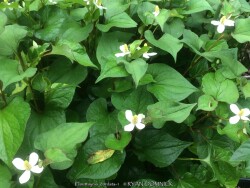

>>>>>This plant can also be used as a marginal aquatic plant growing in shallow water. It can also grow as a bog plant needing constantly moist soil rich in organic matter. As a rain garden plant, it will thrive is a depressed area in the landscape that collects rain water from a roof during spring and summer periods of rain but then go dormant if the water hole dries out completely.>>>>>For the home garden, the species is generally too aggressive to mix with other plants
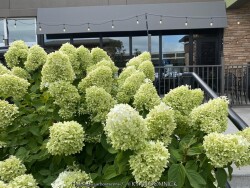

***Description for this plant available with future update!***>>>>> Spring Meadows nursery says "Literally, a huge improvement over 'Annabelle'! Our goal in creating Incrediball® hydrangea was to develop a non-flopping version of 'Annabelle.' What we ultimately selected, though, was even better: a powerhouse of a plant that not only has strong, sturdy, supportive stems, but also extra large flowers. On mature plants, they can become as large as basketballs! Blooms age to a beautiful jade green through summer and fall. Don't let its good looks fool you, though - this North American native is super hardy and tough as nails."
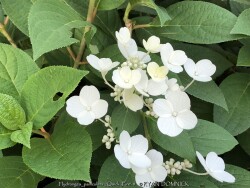

Quick Fire Fab® Panicle Hydrangea (Hydrangea paniculata 'Quick Fire Fab') is the first to bloom! Quick Fire blooms about a month before any other panicle hydrangea. Flowers open pure white then turn pink, and will be an extremely dark rosy-pink in the fall. The flower color on Quick Fire hydrangea is not affected by soil pH. Blooms on this super-hardy and easy to grow hydrangea are produced on new wood, which means that you will see flowers even after even the harshest winters. Beautiful for use as a cut (fresh or dried) flower. Unlike other panicle hydrangeas, Quick Fire Fab also has excellent fall foliage color for a final hurrah before winter. This is a very hardy flowering shrub good for full sun locations - the hotter your climate, however, the more shade the plant will require. Good for groupings and in mass plantings, shrub and perennial borders, as a specimen, a screen or a hedge. Panicle hydrangeas like Quick Fire Fab are very easy to care for. They can grow in most soils, provided they are well-drained. Panicle hydrangeas bloom on new wood, which means they can be pruned in spring and will still bloom that season. We recommend cutting them back by about one-third their total height in early spring, just as the new growth is beginning to emerge on the stems. This will serve to remove the spent blooms and ensure that the season's growth comes from the heavier, thicker buds further down the plant. If blooms do not age to pink and red, this indicates that the plant is either in too much shade, that it experienced drought stress, or that night time temperatures were unusually high. In Eastern Kansas, this cultivar performs reasonably well. Heat and drought are tolerated if in morning sun. In full sun provide ample water and expect some leaf burn if summer temperatures exceed 100 degrees F. Cold tolerance is no problem. No disease or pest problems. All Proven Winners® plants are legally propagated, healthy and vigorous, true to name, and tagged with color pictures and growing information.
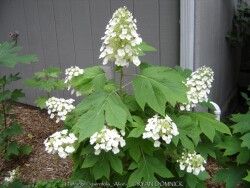

>>>>>Oakleaf hydrangea (Hydrangea quercifolia) is a large coarse-textured deciduous shrub growing to 3-10 feet tall with an open crown native to the southeastern United States. Cone-shaped flower clusters emerge bright white in mid-summer. Flowers age to progressively darker shades of pink and by autumn and become persistent dried flower-heads in winter. The leaves are dark green on top and silvery-white underneath. Plants in shade have larger leaves than those grown in sun. In sun, if drought stress occurs, foliage becomes tattered, burnt, and yellowish; ruining potential fall color. The leaves of healthy plants turn rich shades of red, bronze and purple in autumn that persist until about 25 degrees F usually into late November in Kansas. The plant slowly sprouts shoots from underground stolons and often grows in colonies in ideal conditions but this is rare in Kansas. Young stems are covered in a felt-like light brown bark while the larger stems develop an attractive cinnamon-tan-orange bark that shreds and peels in thin flakes. Hydrangea quercifolia is best grown in rich, medium moisture, well-drained soils in part shade. Drought and full sun tolerance are average but greatly improved with rich, moisture-retentive foresty soils. Plant near gutter downspouts for an extra boost of water. It will tolerate drought, but may not flower. In Eastern Kansas, Cold tolerance is no problem. No significant disease or pest problems. Of all the hydrangeas, this is probably the toughest! Several improved cultivars have been developed.
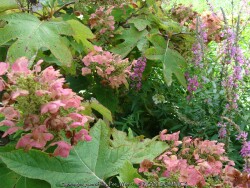

>>>>>Oakleaf hydrangea (Hydrangea quercifolia) is a large coarse-textured deciduous shrub growing to 3-10 feet tall with an open crown native to the southeastern United States. Cone-shaped flower clusters emerge bright white in mid-summer. Flowers age to progressively darker shades of pink and by autumn and become persistent dried flower-heads in winter. The leaves are dark green on top and silvery-white underneath. Plants in shade have larger leaves than those grown in sun. In sun, if drought stress occurs, foliage becomes tattered, burnt, and yellowish; ruining potential fall color. The leaves of healthy plants turn rich shades of red, bronze and purple in autumn that persist until about 25 degrees F usually into late November in Kansas. The plant slowly sprouts shoots from underground stolons and often grows in colonies in ideal conditions but this is rare in Kansas. Young stems are covered in a felt-like light brown bark while the larger stems develop an attractive cinnamon-tan-orange bark that shreds and peels in thin flakes. Hydrangea quercifolia is best grown in rich, medium moisture, well-drained soils in part shade. Drought and full sun tolerance are average but greatly improved with rich, moisture-retentive foresty soils. Plant near gutter downspouts for an extra boost of water. It will tolerate drought, but may not flower. In Eastern Kansas, Cold tolerance is no problem. No significant disease or pest problems. Of all the hydrangeas, this is probably the toughest! Several improved cultivars have been developed.


***Description for this perennial available with future update!***
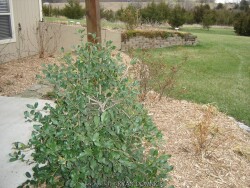



Berry Poppins & Mr. Poppins Combo Winterberry, is also known as Ilex verticillata 'Berry Poppins & Mr. Poppins'
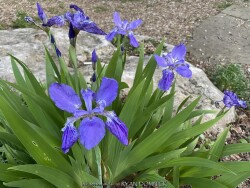

Japanese Roof Iris (Iris tectorum) is a rhizomatous perennial iris species with attractive clusters of wide fan-like foliage. It is native of China and Korea, with lavender-blue, bluish-violet, purple-blue, blue-lilac or sky blue flowers. Although flowers are attractive, this plant is grown just as much for its foliage. It prefers to grow in rich, well-drained, forest soil in part shade. This plant will grow in thin soils on top of rock outcroppings provided that moisture is available; Iris tectorum is commonly called 'roof iris' because it was grown in the thatch of Chinese and Japanese houses. Mostly used in Kansas gardens as an accent or curiosity plant.
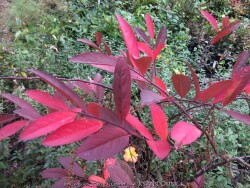

Virginia sweetspire (Itea virginica) is a native shrub found along creeks and streams in the eastern United States. Foliage consists of a simple leaf, medium to light green, and usually glossy. White cascading flowers cover the plants in spring for about a month with pollinators flocking to the occasion. Fall color is outstanding shades of red and purple. Leaves cling to the stem and are very persistent down to about 10-15°F often finally dropping in December. Stems during the winter take on an attractive reddish-brown and green coloring. Sweetspire is truly a four-season shrub! In the landscape, combine with native plants, hardy tropicals, or summer flowering plants. These plants can tolerate saturated soils and are perfect for rain gardens or any other rich soil garden areas. North exposures are fine in zone 6 but not any further north as winter kill becomes a problem in zone 5. Water is usually the limiting factor in southern climates zone 7-9. Sweetspire is highly sensitive to iron chlorosis so avoid alkaline soils. In our eastern Kansas climate, we avoid afternoon sun and dry soils. Full shade is tolerated but not dry shade. Fall color will be reduced or nonexistent in full shade. Morning sun is best for avoiding leaf burn but still allowing fall coloring. Overall, this is a great garden plant when sited in the right conditions. Itea virginica 'Henry's Garnet' has larger flowers and better fall color compared to the species.
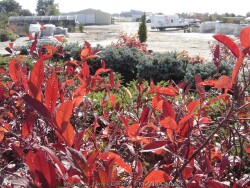

Virginia sweetspire (Itea virginica) is a native shrub found along creeks and streams in the eastern United States. Foliage consists of a simple leaf, medium to light green, and usually glossy. White cascading flowers cover the plants in spring for about a month with pollinators flocking to the occasion. Fall color is outstanding shades of red and purple. Leaves cling to the stem and are very persistent down to about 10-15°F often finally dropping in December. Stems during the winter take on an attractive reddish-brown and green coloring. Sweetspire is truly a four-season shrub! In the landscape, combine with native plants, hardy tropicals, or summer flowering plants. These plants can tolerate saturated soils and are perfect for rain gardens or any other rich soil garden areas. North exposures are fine in zone 6 but not any further north as winter kill becomes a problem in zone 5. Water is usually the limiting factor in southern climates zone 7-9. Sweetspire is highly sensitive to iron chlorosis so avoid alkaline soils. In our eastern Kansas climate, we avoid afternoon sun and dry soils. Full shade is tolerated but not dry shade. Fall color will be reduced or nonexistent in full shade. Morning sun is best for avoiding leaf burn but still allowing fall coloring. Overall, this is a great garden plant when sited in the right conditions. Itea virginica 'Merlot' features more mounded, compact stature and more persistant burgundy fall color making it an improvement over older varieties such as the old favorite 'Henry's Garnet'. Flowers are scented!
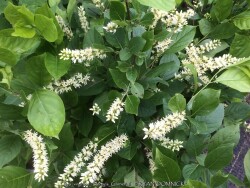

Virginia sweetspire (Itea virginica) is a native shrub found along creeks and streams in the eastern United States. Foliage consists of a simple leaf, medium to light green, and usually glossy. White cascading flowers cover the plants in spring for about a month with pollinators flocking to the occasion. Fall color is outstanding shades of red and purple. Leaves cling to the stem and are very persistent down to about 10-15°F often finally dropping in December. Stems during the winter take on an attractive reddish-brown and green coloring. Sweetspire is truly a four-season shrub! In the landscape, combine with native plants, hardy tropicals, or summer flowering plants. These plants can tolerate saturated soils and are perfect for rain gardens or any other rich soil garden areas. North exposures are fine in zone 6 but not any further north as winter kill becomes a problem in zone 5. Water is usually the limiting factor in southern climates zone 7-9. Sweetspire is highly sensitive to iron chlorosis so avoid alkaline soils. In our eastern Kansas climate, we avoid afternoon sun and dry soils. Full shade is tolerated but not dry shade. Fall color will be reduced or nonexistent in full shade. Morning sun is best for avoiding leaf burn but still allowing fall coloring. Overall, this is a great garden plant when sited in the right conditions. Itea virginica 'Scentlandia' adds sweet summertime fragrance to the host of other improvements like compact growth, improved flowerbud hardiness, and improved red fall color. All Proven Winners® plants are legally propagated, healthy and vigorous, true to name, and tagged with color pictures and growing information.
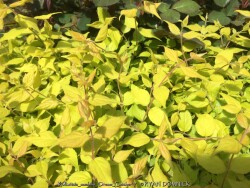

Dream Catcher Beautybush, is also known as Kolkwitzia amabilis 'Dream Catcher'
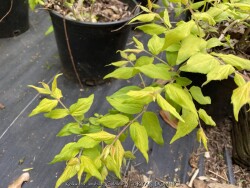

Goldleaf/Golden Beauty Beautybush, is also known as Kolkwitzia amabilis 'Goldleaf'


Dream Catcher Beautybush, is also known as Kolkwitzia amabilis 'Dream Catcher'
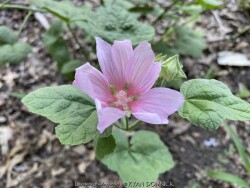

***Shrub descriptions available with future update!***
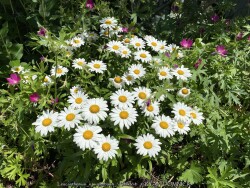

***Description for this perennial available with future update!***


Stargazer Garden Lily, is also known as Lilium 'Stargazer'
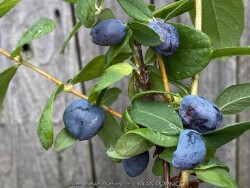

Also called Honeyberries, Japanese Haskap, or Yezberry® (Lonicera caerulea), these shrubs are easy-to-grow fruiting plants developed for their large, delicious blue fruit. Yezberry® are extremely cold hardy and able to bear fruit in zones 3-7. Plant with another Yezberry® variety for an abundant fruit set on both plants. However, as an ornamental shrub, late summer Kansas heat stress will likely cause partial to complete defoliation. This does not affect the fruit quality or overall health of the shrub as the flower buds for next year are already formed. Ultra cold-hardy plants from northern climates normally dislike our long hot humid summers; although we are on the Southern edge of this plants adaptability, it still survives reasonably well here. Look for a cold microclimate planting location such as East or North exposure. In Eastern Kansas, typically our 40 inches of rainfall is sufficient without extra water. All Proven Winners® plants are legally propagated, healthy and vigorous, true to name, and tagged with color pictures and growing information.
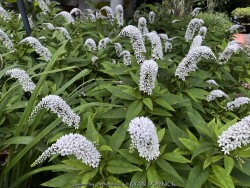

>>>>>For the home garden in rich well irrigated areas, this species can be too aggressive from self-seeding to mix with other plants. Use as a mass planting in poor un-irrigated soils only. However, in a difficult dry-shade garden, it will thrive, flower, and be relatively tame.>>>>>This plant can also be used as a marginal aquatic plant growing in shallow water. It can also grow as a bog plant needing constantly moist soil rich in organic matter. As a rain garden plant, it will thrive is a depressed area in the landscape that collects rain water from a roof during spring and summer periods of rain but then go dormant if the water hole dries out completely.
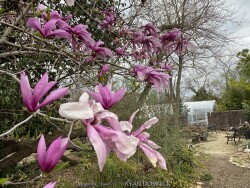

Jane Magenta Flowering Magnolia (Magnolia 'Jane'), noted for its compact, upright habit, grows best in organically rich, medium-moisture soil that's neutral to slightly acidic. Reddish purple flowers with white interiors open later in spring to avoid frost damage. Flowers do seem to tolerate light freezes down to 28 degrees that have occured here at our Lawrence, KS display garden without damage. Flowers are a gorgeous tulip shape with a lightly scented fragrance. Leaves are medium to dark green turning a beautiful gold in the fall. Jane magnolia makes a great understory small tree, specimen plant, or background shrub slowly growing 10'-15' high. Grows best in full morning sun and partially shaded afternoons in hot climates. Avoid hot West or South exposures and winds. Magnolias in general are a family of plants that have been around for millions of years and are among the most primitive of all flowers. In fact, most magnolia flowers evolved before bees and are thus pollinated by beetles. Magnolias generally grow in moist, well drained soils in sun or shade. They have no serious pests or disease problems. Occasionally seen listed as Magnolia liliflora 'Reflorescens' x stellate 'Waterlily'


Magnolia grandiflora 'Bracken's Brown Beauty' is one of the most cold hardy of the Southern Magnolias. Magnolias in general are a family of plants that have been around for millions of years and are among the most primitive of all flowers. In fact, most magnolia flowers evolved before bees and are thus pollinated by beetles. Magnolias generally have no serious pests or diseases. Any of the dwarf Southern Magnolia cultivars serve as a beautiful four seasons small tree or large shrub. Evergreen foliage is a shiny dark green with a brown-orange back that first emerges lighter green. If temperature stay above -10°F, foliage generally stays intact. If colder than that, it will shed its leaves like a deciduous tree when new growth occurs in April. Large tropical-looking white scented flowers bloom in late May and early June. Green cones, yes cones, follow in late summer with the cones opening up to yield beautiful red seeds. Seeds are viable but will not survive the winter here. Bracken's Brown Beauty Magnolias appreciate rich well-drained soil but will tolerate less than ideal clay soils. Sandy or rocky soils are tolerated if watering is sufficient. Magnolias can tolerate short periods of poor drainage but not consistent bog like conditions. Full sun is best but WELL-CARED for Magnolias can tolerate mostly shade in rich soils. This means do not use Magnolias under walnut trees, in dry shade, or exposed to north winds on the north side of a house. Being one of the few broadleaf evergreens hardy in zone 6, Bracken's Brown Beauty has many landscape uses. Several trees planted in a row or group will make an awesome wind and visual screen without the pest problems of coniferous evergreens. If ice or snow damage occurs, Magnolias have the ability to grow back reasonably quickly as opposed to most coniferous evergreens. In fact, Magnolias will come back from the ground is completely cut down and new growth from water sprouts will be rapid. Magnolias also make a great specimen tree or background for flowers and shrubs. Magnolias can be planted near a house without worrying about damaging root systems; they are very easily pruneable if they start getting too big. This highly-rated small landscape tree is perfect somewhere on your property!
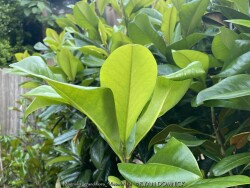

Magnolia grandiflora 'Victoria' is one of the most cold hardy of the Southern Magnolias. Magnolias in general are a family of plants that have been around for millions of years and are among the most primitive of all flowers. In fact, most magnolia flowers evolved before bees and are thus pollinated by beetles. Magnolias generally have no serious pests or diseases. Any of the dwarf Southern Magnolia cultivars serve as a beautiful four seasons small tree or large shrub. Evergreen foliage is a shiny dark green with a brown-orange back that first emerges lighter green. If temperature stay above -10°F, foliage generally stays intact. If colder than that, it will shed its leaves like a deciduous tree when new growth occurs in April. Large tropical-looking white scented flowers bloom in late May and early June. Green cones, yes cones, follow in late summer with the cones opening up to yield beautiful red seeds. Seeds are viable but will not survive the winter here. Victoria Hardy Southern Magnolias appreciate rich well-drained soil but will tolerate less than ideal clay soils. Sandy or rocky soils are tolerated if watering is sufficient. Magnolia's can tolerate short periods of poor drainage but not consistent bog like conditions. Full sun is best but WELL-CARED for Magnolias can tolerate mostly shade in rich soils. This means do not use Magnolias under walnut trees, in dry shade, or exposed to north winds on the north side of a house. Being one of the few broadleaf evergreens hardy in zone 6, Victoria Hardy Southern Magnolia has many landscape uses. Several trees planted in a row or group will make an awesome wind and visual screen without the pest problems of coniferous evergreens. If ice or snow damage occurs, Magnolias have the ability to grow back reasonably quickly as opposed to most coniferous evergreens. In fact, Magnolias will come back from the ground is completely cut down and new growth from water sprouts will be rapid. Magnolias also make a great specimen tree or background for flowers and shrubs. Magnolias can be planted near a house without worrying about damaging root systems; they are very easily pruneable if they start getting too big. This highly-rated small landscape tree is perfect somewhere on your property!
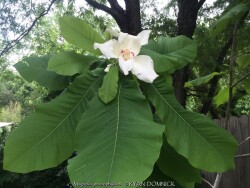

Bigleaf Magnolia (Magnolia macrophylla) features very large light green leaves that are the biggest simple leaf in North America measuring upto 36" long! They are native to pockets of the Appalachian mountains with perfect rich soils and protected from winds. One would think that plant like this would not do well in Kansas landscapes. However if given a little bit of wind protection, some watering, and decent soil, these trees will do fine and grow vigorously growing in sun or shade. Big leaf magnolias also produce large creamy white flowers and have silvery backs to their leaves adding to the appeal. With ideal conditions, a growth rate of 1 to 2 feet per year is possible. With more difficult conditions they will grow a few inches per year but still look attractive. There seems to be no other plant that can add a tropical feel like big leaf Magnolia. Magnolias in general are a family of plants that have been around for millions of years and are among the most primitive of all flowers. In fact, most magnolia flowers evolved before bees and are thus pollinated by beetles. Magnolias generally have no serious pests or diseases.
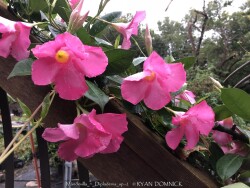

There are many varieties of the tropical vining flowers called Mandevilla / Dipladenia sp. The five-petal flowers are very showy and fragrant, blooming all summer until frost. Blooming will also decrease with cooler fall night temperatures. Flower colors typically coming in shades of pink, red, and white, occasionally with yellow throats. Mandevillas thrive in warm, humid weather as a summer patio plant or annual. If growing as a potted plant and trying to overwinter, it is very difficult as these plants do not like low humidity or low light; best to replace each year. Watch out for mealybugs and spider mites indoors.
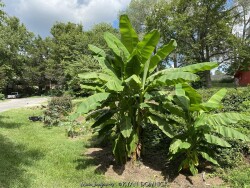

Create a tropical effect in your landscape with these large fast-growing cold hardy Musa basjoo! (also called Japanese fiber banana) Each leaf can be 6 feet long and 2 feet wide. Leave in ground and mulch 6" thick and they will return as perennials every year. If planting on the south side of a house in full sun, little protection is needed. These have proven hardy in Lawrence, KS (zone 6a) for over 20 years. In Eastern Kansas, typically our 40 inches of rainfall is sufficient without extra water in good soils. This species will tolerate some degree of drought but fastest growth will occur in rich well-drained soils with extra water and fertilizer provided during the summer. Great for summer wet areas in full sun or around swimming pools (creates no messes). Plants are capable of growing 15-18 feet by the end of summer when established and happy! A more realistic height is 7-12 feet under average conditions. Banana trees will slowly divide and send up offsets; this is a desirable sign that the banana tree is establishing well. If 1-2 feet of trunk is protected with a large pile of leaf mulch, you will get a flower followed by small inedible bananas the 2nd year on the largest trunk. The flowering trunk will die but the offsets will grow. Bananas will not tolerate excessively wet soils during dormancy. Sunburning can happen with summer temperatures over 100 degrees F but it will quickly outgrow the damage. Bananas need at least 1/2 day of full sun and protection from excessive winds to properly grow. Listed by many sources as hardy to zone 6 or 7, with proper mulching and placement near a foundation, you can easily grow this into zone 5 or possibly lower. In our trial gardens in Lawrence, KS (zone 6a), two well established specimens have thrived for 15 years and counting. During the arctic blast of February, 2021, lows down to -17 degrees F on Feb 16th, 2021 were recorded. The longevity of this cold blast was also impressive: 10 days on a row with highs of 10-15 degrees F or lower, 8 nights of lows in the single digits and negatives, and 36 straight hours of 0 degrees F and mostly lower. A hard ground freeze was inevitable; hundreds of plants around town survived this event returning a little late the following spring but otherwise just fine. Some were mulched with ground up leaf mulch, some were not.
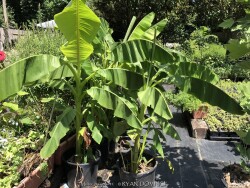

Create a tropical effect in your landscape with these large fast-growing cold hardy Musa basjoo! (also called Japanese fiber banana) Each leaf can be 6 feet long and 2 feet wide. Leave in ground and mulch 6" thick and they will return as perennials every year. If planting on the south side of a house in full sun, little protection is needed. These have proven hardy in Lawrence, KS (zone 6a) for over 20 years. In Eastern Kansas, typically our 40 inches of rainfall is sufficient without extra water in good soils. This species will tolerate some degree of drought but fastest growth will occur in rich well-drained soils with extra water and fertilizer provided during the summer. Great for summer wet areas in full sun or around swimming pools (creates no messes). Plants are capable of growing 15-18 feet by the end of summer when established and happy! A more realistic height is 7-12 feet under average conditions. Banana trees will slowly divide and send up offsets; this is a desirable sign that the banana tree is establishing well. If 1-2 feet of trunk is protected with a large pile of leaf mulch, you will get a flower followed by small inedible bananas the 2nd year on the largest trunk. The flowering trunk will die but the offsets will grow. Bananas will not tolerate excessively wet soils during dormancy. Sunburning can happen with summer temperatures over 100 degrees F but it will quickly outgrow the damage. Bananas need at least 1/2 day of full sun and protection from excessive winds to properly grow. Listed by many sources as hardy to zone 6 or 7, with proper mulching and placement near a foundation, you can easily grow this into zone 5 or possibly lower. In our trial gardens in Lawrence, KS (zone 6a), two well established specimens have thrived for 15 years and counting. During the arctic blast of February, 2021, lows down to -17 degrees F on Feb 16th, 2021 were recorded. The longevity of this cold blast was also impressive: 10 days on a row with highs of 10-15 degrees F or lower, 8 nights of lows in the single digits and negatives, and 36 straight hours of 0 degrees F and mostly lower. A hard ground freeze was inevitable; hundreds of plants around town survived this event returning a little late the following spring but otherwise just fine. Some were mulched with ground up leaf mulch, some were not.
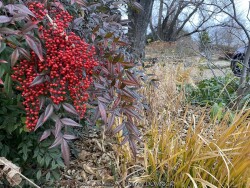

Nandina domestica is also called "Nandina" or "Heavenly Bamboo" despite not spreading or being related to bamboo at all. It is native to warm temperate climates in China. Bamboo-like foliage is very attractive with new growth emerging coppery peach with shades of pink and red in spring. During the summer, the foliage maintains a glossy deep to medium green color with no pest problems. White flowers appear which eventually turn into red fruits in the fall. Most birds do not like the fruit so they persist very well into winter down to about 0° F before freeze-drying to a reddish brown color and falling off. Often around Christmas time, the berries make a spectacular show combining classic colors of red and green in the winter landscape. The berries can be poisonous to some birds if they eat too many and all other food sources are depleted. This is a problem in your yard, please remove the fruits in the winter or before we have an arctic blast in which birds get desperate and will eat anything. The foliage is evergreen down to about -5° F and if colder, will simply become a deciduous shrub that year. If winter temperatures reach -10 or with strong winds, nandina will die to the ground like a perennial and come up from the base in April. In some parts of the country where winterkill never happens, nandina are invasive. (fruits spread by birds) This is likely in the Southeast and Texas south of zone 8b with plenty of rainfall. In those areas nandina will slowly take over the forest and displace native plants. There are many fruitless cultivars that can be used if invasiveness is a problem. In Kansas and in zone 5-7, This is never a problem because extreme winters keep the plant "in-check" and kill any seedlings trying to germinate. This shrub has a four-season appeal and is great for adding interest to Kansas landscapes in the winter. Best growth in Lawrence, KS (zone 6a) occurs when planted on South or West exposures benefiting from the hot micro climate. Nandina will also grow in just about any soil with full shade to full sun. If planted in full shade, growth will be very slow and extreme winters may kill them if not established; plant in spring only in this situation. Nandina look best in small to large groups. After established, its a "once it's there it's there forever" plant with very little maintenance. The only maintenance is cutting back winter kill occasionally or pruning to a more desirable mounded shape. It is worth noting that dwarf fruitless cultivars are less hardy in marginal zone 6 climates because of reduced ability to quickly recover from an occasional extreme winter.
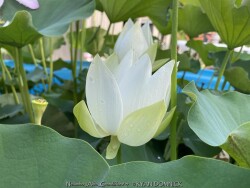

Alba Grandiflora Water Lotus, is also known as Nelumbo 'Alba Grandiflora'
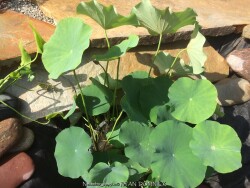

American Native Water Lotus, is also known as Nelumbo lutea


Moon Dance White Water Lily, is also known as Nymphaea 'Moon Dance'
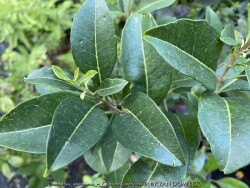

Devilwood (Osmanthus americanus / Cartrema americana) has very hard and dense wood, hence the name. It is a slow-growing evergreen shrub or small tree native to southeastern North America and Mexico. Bright green simple leaves emerge in spring turning deeper green in summer. Cream white flowers borne on separate trees and female trees produce abundant blue/black fruit. Growth habit is somewhat open so don't count on it to provide screening or density. Grows in sun or shade but in the northern part of its range, growth is too slow and sparse in the shade. Devilwood grows in most soils including moist ones and occasional flooding. This making it an ideal rain garden plant. Becoming more drought tolerant when established, our 40 inches of typical rainfall in Eastern Kansas is sufficient if planted in good soils. The cold hardiness is surprising: as a zone 5, this could be one of the most cold-tolerant broadleaf evergreens trees available! It survived -16 degrees F and a week of single digit highs in February, 2021 with no damage. It even maintains bright green foliage in winter opposed to a dingy brownish-green like some evergreens. Useful in the garden as a background evergreen shrub or small tree. Sold as Osmanthus americanus, Cartrema americana is technically it's new botanical name.
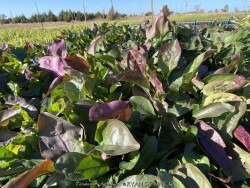

Foxglove Beardtongue / Native Penstemon, is also known as Penstemon digitalis. >>>>>


Husker Red Penstemon, is also known as Penstemon digitalis 'Husker Red'